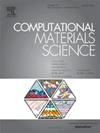Transition metal atom catalysts suppress the shuttle effect: a first-principles study
IF 3.3
3区 材料科学
Q2 MATERIALS SCIENCE, MULTIDISCIPLINARY
引用次数: 0
Abstract
The theoretical energy density of lithium-sulfur batteries (LSBs) reaches as high as 2600 mA·h·g−1. However, challenges such as poor sulfur conductivity, the polysulfide shuttle effect, and sluggish Li2S(the product of sulfur reduction reaction) oxidation kinetics have significantly hindered their practical development. Building on first-principles calculations, this study provides an in-depth analysis of the anchoring and catalytic performance of single-atom catalysts embedded in two-dimensional GeC monolayers (TM-GeC), investigating their potential as sulfur composite materials for LSBs. Through calculations of their structural stability, adsorption capacity, conductivity, charge transfer and Li2S oxidation kinetics, it was determined that Fe-GeC and Co-GeC exhibit outstanding properties as potential sulfur host materials, anchoring lithium polysulfides (LiPSs) effectively. The material also maintains exceptional electrical conductivity, both prior to and following the adsorption of LiPSs. This property allows the entire system to exhibit metallic behavior and substantially lowers the free energy associated with the sulfur reduction reaction. In addition, the adsorption and catalytic mechanisms of Fe-GeC and Co-GeC have been elucidated, providing novel perspectives for the design of sulfur composite materials that possess superior anchoring capacity and catalytic performance.

过渡金属原子催化剂抑制穿梭效应:第一性原理研究
锂硫电池的理论能量密度高达2600 mA·h·g−1。然而,硫电导率差、多硫穿梭效应和硫还原反应产物Li2S氧化动力学缓慢等挑战阻碍了它们的实际发展。在第一性原理计算的基础上,本研究深入分析了嵌入二维GeC单层(TM-GeC)的单原子催化剂的锚定和催化性能,探讨了它们作为lbs硫复合材料的潜力。通过对Fe-GeC和Co-GeC的结构稳定性、吸附能力、电导率、电荷转移和Li2S氧化动力学的计算,确定了Fe-GeC和Co-GeC作为潜在的硫宿主材料具有出色的性能,可以有效地锚定锂多硫化物(LiPSs)。该材料在吸附LiPSs之前和之后都保持了优异的导电性。这一特性使整个体系表现出金属行为,并大大降低了与硫还原反应相关的自由能。此外,本文还阐明了Fe-GeC和Co-GeC的吸附和催化机理,为设计具有优异锚定能力和催化性能的硫复合材料提供了新的视角。
本文章由计算机程序翻译,如有差异,请以英文原文为准。
求助全文
约1分钟内获得全文
求助全文
来源期刊

Computational Materials Science
工程技术-材料科学:综合
CiteScore
6.50
自引率
6.10%
发文量
665
审稿时长
26 days
期刊介绍:
The goal of Computational Materials Science is to report on results that provide new or unique insights into, or significantly expand our understanding of, the properties of materials or phenomena associated with their design, synthesis, processing, characterization, and utilization. To be relevant to the journal, the results should be applied or applicable to specific material systems that are discussed within the submission.
 求助内容:
求助内容: 应助结果提醒方式:
应助结果提醒方式:


